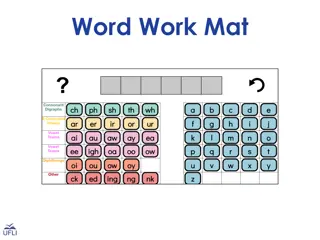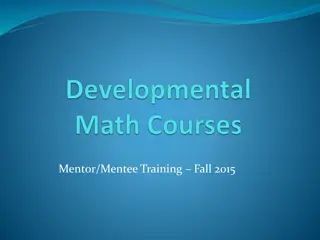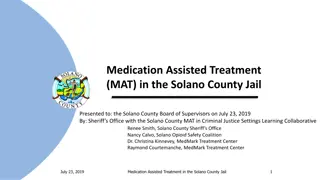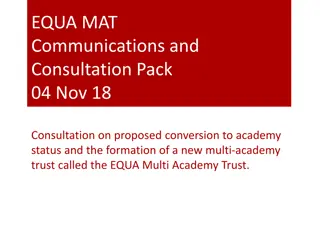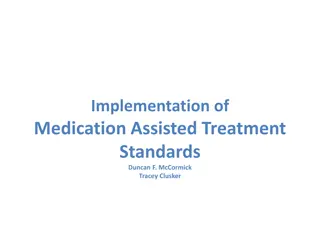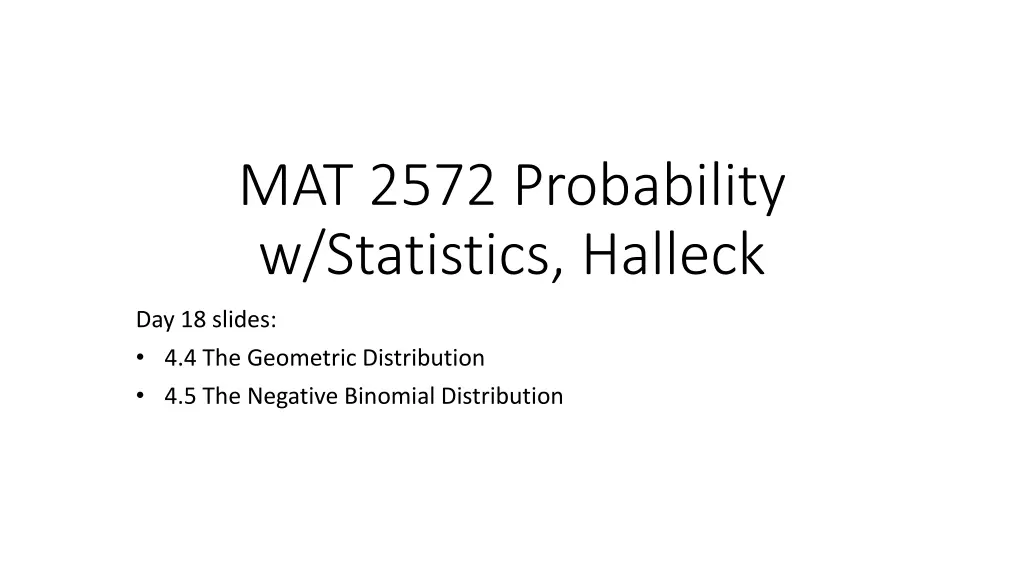
Probability Distributions and Examples
Explore the Geometric Distribution and Negative Binomial Distribution, along with examples and calculations on the probabilities of outcomes in various scenarios. Understand the concepts of success, failure, and the number of trials before specific successes occur. Dive into practical applications such as determining the number of purchases needed to earn a bookstore privilege and calculating probabilities of specific events in trials involving dice rolls.
Download Presentation

Please find below an Image/Link to download the presentation.
The content on the website is provided AS IS for your information and personal use only. It may not be sold, licensed, or shared on other websites without obtaining consent from the author. If you encounter any issues during the download, it is possible that the publisher has removed the file from their server.
You are allowed to download the files provided on this website for personal or commercial use, subject to the condition that they are used lawfully. All files are the property of their respective owners.
The content on the website is provided AS IS for your information and personal use only. It may not be sold, licensed, or shared on other websites without obtaining consent from the author.
E N D
Presentation Transcript
MAT 2572 Probability w/Statistics, Halleck Day 18 slides: 4.4 The Geometric Distribution 4.5 The Negative Binomial Distribution
Geometric Distribution Consider a series of independent trials, each having one of two possible outcomes, success or failure. Let p= P(success). Define the random variable X to be the number of failures BEFORE the first success occurs. pG(k) = P(G = k) = P(First success occurs on the (k+1)sttrial) = P(First k trials end in failure and (k+1)sttrial ends in success) = P(First k trials end in failure) P((k+1)sttrial ends in success) =qkp, k =0, 1, . . .
Geometric Distribution (cont.) ? ? = 0? + 1?? + 2??2+ 3??3 = ?? 1 + 2?1+ 3?2 ? = ?? ? + ?2+ ?3 = ?? 1 ? 1 ?2 =? = ??(1 1 ? ?( 1))/(1 ?)2) = ?? ? 2 Similarly E(G2) =? 1+? ?2 , thus 2=? 1+? ? ? ? ?2. = ?2
Example 4.4.2: Example 4.4.2: Sum of 4 geometrics Our bookstore has a promotion. For every $100 of textbooks purchased, you get a letter T, E, C or H. If you get all 4 letters, you can sell back your books for 100% of purchase price as long as you remain a student. On average, how many $100 s do you need to spend before you earn this privilege. Let Gibe RV representing the $100 s you spend unsuccessfully before adding ithletter. Let X represent total # of $100 s you spend. Then X=(G1+1)+(G2+1)+ +(G4+1)= ?=1 For Gi, there are 5 i letters still to find. Hence chance of getting new one ? =5 ? 4 4 ??+ 4 and E(G)= ?=1 ? ?? + 4 4and ? = 1 5 ? 2+3 4=? 1 4. ? 1 5 ?+ 4 =0 4+1 3+2 1+ 4 = 81 4 So ? ? = ?=1 3or $833.
Negative Binomial Distribution Consider a series of independent trials, each having one of two possible outcomes, success or failure. Let p= P(success). Define the random variable NB to be the number of failures before the rthsuccess occurs. pNB(k) = P(NB = k) = P(rthsuccess occurs on the (r+k)thtrial) = P(r 1 successes occur in first r + k 1 trials and success occurs on the (r+k)thtrial) = P(r 1 successes occur in first r + k 1 trials) P((r+k)thtrial ends in success) ?+? 1 ? 1 ?? 1??+? 1 (? 1)? = ?+? 1 ? 1 ????, k =0, 1, . . . =
Rinaldi: 3.2.2, example 13 Roll a fair die. What is probability that 2nd6 appears on 10throll? What is success? 6 so ? =1 6. What is failure? Anything but 6 so ? =5 6. How many failures have happened? 10 2 = 8 (so k=8) How many successes have happened? 2 (so r=2) 2 8 58 610 6% 1 6 5 6 ?+? 1 ? 1 2+8 1 2 1 9 1 ????so ? 8 = ?(?) = =
Rinaldi: 3.2.2, example 14 What is chance that the 5thchild of couple is their 2ndgirl? What is success? girl so ? =1 2. What is failure? boy so ? =1 2. How many failures have happened? 5 2 = 3 (so k=3) How many successes have happened? 2 (so r=2) 2 3 1 2 1 2 1 32=1 ?+? 1 ? 1 2+3 1 2 1 4 1 ????so ? 3 = ?(?) = = 8
Negative Binomial: expectation & variance Consider a series of independent trials, each having one of two possible outcomes, success or failure. Let p= P(success). Define the random variable X to be the number of failures before the rthsuccess occurs. then: pX(k) = ?+? 1 ? 1 ????, k =0, 1, . . . X is sum of r independent RV s G1+G2+...+Gr where each Giis a geometric distribution with the same chance of success p. Using expectation and variance theorems for sums of independent random variables we get the following: E(NB) =?? ?2 ?, 2=??
Rinaldi: 3.2.2, example 14 cont. What is expectation for which child will be the 2ndgirl? Recall that ? = ? =1 2. How many successes have happened? 2 so r=2 How many failures have happened? variable (k=0, 1, .) What is expectation for number of failures? E(X) =?? ?=2(.5) = 2 .5 So Expectation for # of births is E(X+2)=E(X)+2 = 2 + 2 = 4 i.e., on average, the 2ndgirl will be born as the 4thchild.
Example 4.5.1 Baseball strike Example 4.5.1 Baseball strike The Yankees go on strike due to conflict with management. Their tactic is to play passively. In particular, at bat, they will not swing. On average, how many runs will they score if the opposing pitcher has a 50% chance of getting a strike? We consider expectation for just one inning. Using properties of expectation, we then multiply by 9. To get on base, a batter must reach 4 balls before 3 strikes. This is NB with r = 4 and k = 0, 1 or 2: 4+? 1 2 4+? 1 4 1 2 P(walk)= ?=0 4 5 6 1 2 1 2 1 2 1 16+ 4 32+10 64=11 4+0 1 3 4+1 1 3 4+2 1 3 = + + = 32
Example 4.5.1 Baseball strike (cont.) Example 4.5.1 Baseball strike (cont.) P(walk)=11 before the 3rdstrike out. This is NB with r=3 and k=3+j. The chance of event is ????= 3 1 32 32 ? 3 1 32 32 (? 3)3+? 1 3 1 32 32 + = E NB 3 + 1.63 =3 11 32and P(strike out)=21 32. To score j runs, the team must have 3+j walks 3 3+?, j =1, 2, . . . 21 11 ?+? 1 ? 1 3+3+? 1 3 3+? 3 ? (? 3)3+? 1 21 11 21 32 11 32 3+3+? 1 So E(runs)= ?=0 = ?=3 3 3 1 +2 3 3 1 3 ? 1 2 21 11 21 32 11 32 11 32 = ?=0 +1 6 21 3 + 1.63 =11 7 3 + 1.63 =.203 So E(X)=9*.203=1.83, i.e., the Yankees will score on average 1.83 runs per game.









